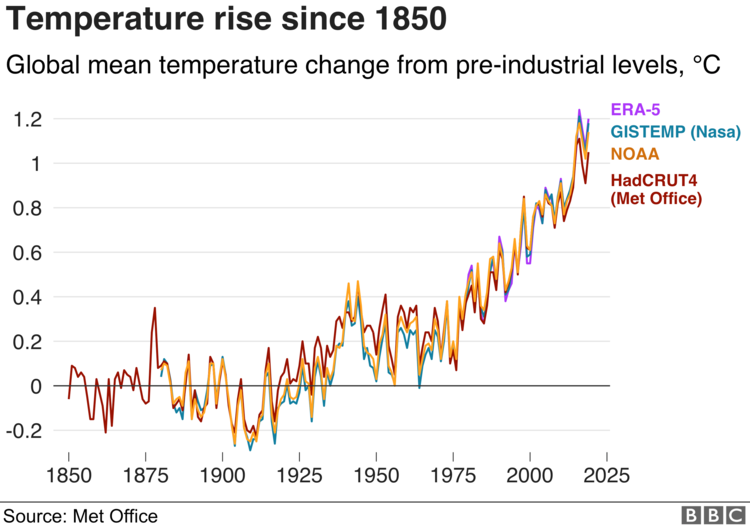Ann Arbor (Informed Comment) – According to the BBC, NOAA, NASA and the UK Met Office have all certified that the decade of the 2010s was the hottest since global scientific records began being systematically kept in 1880. Last year, 2019, was 1.8 degrees F. (1 degree C.) hotter than the twentieth century average, so this roller coaster is accelerating.

Australia is on fire because of the climate forcing of carbon dioxide, which just made that continent hotter and dried it out a bit, setting the stage for massive wildfires that have killed a billion animals.
So here’s the real kicker. Teams of scientists have concluded that they had for decades underestimated the potency of carbon dioxide as a heat-trapping gas. Ordinarily sunlight strikes the earth’s surface and its heat mostly bounces right back off, radiating into outer space. But some gases, such as carbon dioxide and methane, keep the heat from journeying out into space. How much heat CO2 will cause to be retained, however, has now been revised upward because of a better understanding of how warming will affect clouds and how they in turn will affect the temperature.
I can’t tell you what bad news this is. Because we’re shoveling 36.8 billion metric tons of carbon dioxide up into our atmosphere every year. This level of emissions had been thought to be like setting off 4 Hiroshima-sized atomic bombs in the atmosphere every second. It turns out there are actually more atomic bombs going off up there than that.
Actually, the 2010s were probably the hottest decade for two million years. The Pleistocene began about 2 million years ago and was an ice age in which global average temperatures were 9-18 degrees F. lower than today. Before that, in the period beginning 3 million years ago, in the middle of the Pliocene (5.2 – 2.6 million years ago), it was a little hotter than today. Average global temperatures are now about 58.7 degrees F. In the mid-Pliocene they were about 72 degrees F.
During the mid-Pliocene, which is the sort of situation we are rapidly heading for, there was no land ice and everywhere on earth was tropical including the poles. So you really have to go back beyond the Pleistocene ice age of the past 2 million years to get temperatures like you see today. We are set, moreover, to add those 9 degrees F. so as to get all the way back to 3 million years ago and the pan-tropicality of the Pliocene. In the mid-Pliocene there were 400 parts per million of carbon dioxide in the atmosphere. Today it is 415 ppm. So our global temperatures just haven’t caught up to our greenhouse reality because we’re putting the CO2 up so fast. But the oceans are deep and cold and will only warm gradually. If we went cold turkey and stopped putting out CO2 (stopped driving gasoline cars, stopped heating with coal e.g.), the oceans would absorb a lot of the CO2 in the atmosphere. But if we keep going as we are, the ocean’s absorptive capacity will be overwhelmed and bye-bye Antarctica.
One study suggests that as early as 2030 we will be entering a Pliocene-like climate situation.
The mercury thermometer was invented in the early 1700s, and the British East Indian Company actually kept a lot of global temperature records in the late 18th and through the 19th century. But it is generally considered that global record-keeping only attained a really reliable density around 1880. But there are other ways to get a fairly good fix on premodern temperatures, including lake and sea sediments and sea shells, ice cores and corals..
—–
Bonus Video:
NASA Goddard: “2019 Was the 2nd-Hottest Year on Record”




 © 2025 All Rights Reserved
© 2025 All Rights Reserved